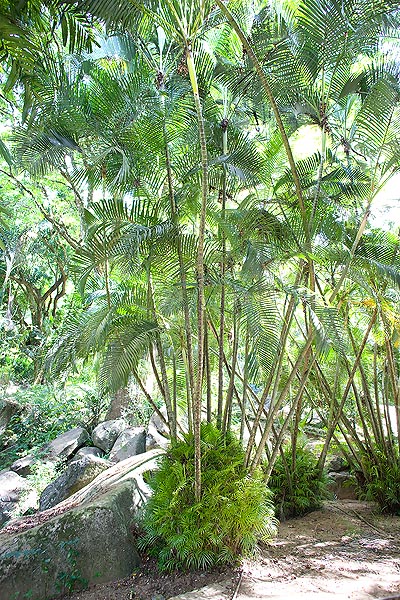Family : Arecaceae

Text © Pietro Puccio

English translation by Mario Beltramini

5-10 cm trunks even 10 m tall © Giuseppe Mazza
The Dypsis lutescens (H.Wendl.) Beentje & J.Dransf. (1995) is native to Madagascar, where it grows in the
forests of the eastern coast, on sandy soils, close to the
sea.
It is known locally (Malagasy), as “lafahazo”, “lafaza” and “rehazo”; in other languages as: “areca” (Italian); “areca palm”, “butterfly palm”, “cane palm”, “golden feather palm”, “golden-yellow palm”, “yellow butterfly palm”, “yellow palm” (English); “palmier cane d’or” (French); “Goldblattpalme”, “Goldfruchtpalme” (German); “palmera amarilla”, “palmera bambu” (Spa- nish); “areca-bambu”, “palmera-areca” (Portuguese).
Cespitose palm with stems tall up to 10 metres and diameter from 5 to about 10 cm, more or less enlarged at the base, and on which are visible the ring, traces of the junction of the fallen-off leaves. The foliar base, of golden colour and covered by a white waxy patina, fully wraps the stem for a height of about 50 cm, thus forming a sort of elegant capital. The leaves, pinnate of glossy pale-green colour, strongly arched, are up to almost two metres long, with leaflets long up to 70 cm in the middle part, and regularly inserted on the rachis to form a V.
Monoecious plant, it produces a ramified inflorescence between the leaves, long about 60 cm, carrying flowers of both sexes disposed on the typical triad (a female flower between two male ones), ovoid fruits, long about 1,8 cm, of yellow colour when ripe. It reproduces by division and by seed, which germinates in about 2 months.
It is one of the most cultivated palms in the tropical and subtropical climate countries, due to the elegance of the appearance and the colour of the foliage; the cultivation in warm temperate climate, in sheltered position, can be tried, as it resists, for short periods, to temperatures around zero. It is also widely cultivated in pot for the decoration of inner spaces.
Synonyms: Chrysalidocarpus lutescens H.Wendl. (1878); Areca flavescens Voss, (1895); Chrysalidocarpus baronii var. littoralis Jum. & H.Perrier (1913); Chrysalidocarpus glaucescens
Waby (1923).
→ For general notions about ARECACEAE please click here.
